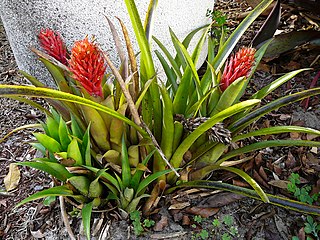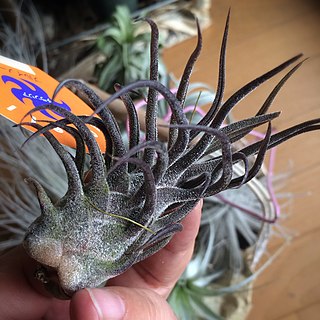
Aechmea bromeliifolia is a bromeliad native to southern Mexico, Central America, Trinidad, and South America as far south as northern Argentina.

Aechmea nudicaulis is a bromeliad species in the genus Aechmea, which is often used as an ornamental plant. This species is native to Central America, the West Indies, central and southern Mexico, and northern and central South America.

Quesnelia testudo is a species of bromeliad in the genus Quesnelia.

Alcantarea imperialis is a species of bromeliad in the genus Alcantarea. This species is endemic to Brazil.
Bromelia binotii is a plant species in the genus Bromelia. This species is endemic to Brazil.

Quesnelia arvensis is a species of bromeliad in the genus Quesnelia.
Quesnelia blanda is a species of flowering plant in the family Bromeliaceae, endemic to southeastern Brazil. It was first described in 1856 as Bromelia blanda. As of November 2022, the Encyclopaedia of Bromeliads listed it under the synonym Quesnelia strobilospica, which it spelt Quesnelia strobilispica.

Vriesea hieroglyphica is a plant species in the genus Vriesea.

Aechmea mertensii is a plant species in the genus Aechmea. This species is native to Bolivia, Brazil, Colombia, Ecuador, Guyana, French Guiana, Peru, Suriname, and Venezuela.

Bromelia antiacantha is a plant species in the genus Bromelia. This species is native to Brazil and Uruguay.

Bromelia karatas is a plant species in the genus Bromelia. This species is native to West Indies and to Latin America from San Luis Potosí and Sinaloa south to Brazil.
Bromelia lagopus is a plant species in the genus Bromelia. This species is native to Brazil.
Bromelia regnellii is a plant species in the genus Bromelia. This species is native to Brazil.
Racinaea spiculosa is a plant species in the genus Racinaea. This species is native to Bolivia, Brazil, Costa Rica, Venezuela and Ecuador.

Tillandsia polystachia is a species of flowering plant in the genus Tillandsia. This species is native to Central America, the West Indies, Bolivia, Colombia, Brazil, Ecuador, Mexico and Venezuela.

Tillandsia pruinosa, is a species of flowering plant in the family Bromeliaceae. It is commonly known as the fuzzywuzzy airplant. This species is native to northern South America, Central America, southern Mexico, the West Indies and Florida.

Vriesea bituminosa is a plant species in the genus Vriesea, endemic to Brazil and Venezuela.
Vriesea friburgensis is a plant species in the genus Vriesea. This species is an epiphyte native to Bolivia, Paraguay, Argentina, and Brazil.

Tillandsia schiedeana is a species of flowering plant in the genus Tillandsia. It was named for the collector Christian Julius Wilhelm Schiede. As an epiphyte, it is found "growing in open tropical forests, and saxicolous, growing on cacti and burseras on steep dry slopes in semiarid regions in Mexico, Central America, West Indies, Venezuela, and Colombia at elevations of 750 to 5,500 feet."

Bromelia laciniosa, natively known as macambira, is plant in the bromeliad family, or in other words, the pineapple family—though not all bromeliads resemble the common pineapple. Bromelia laciniosa is native to Brazil and Argentina but cultivated in many other places.















